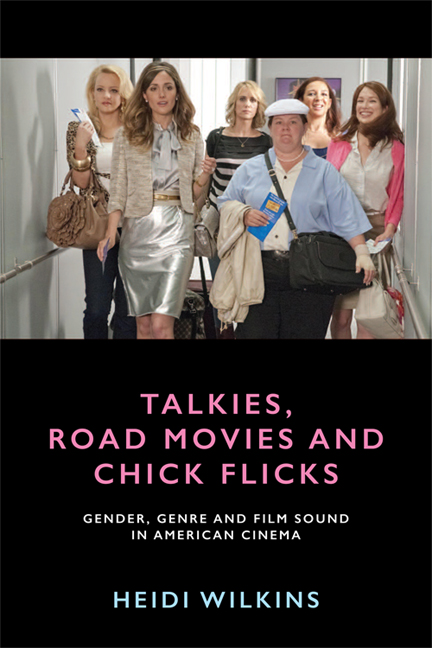Book contents
- Frontmatter
- Contents
- Acknowledgements
- Introduction
- 1 Talking Back: Voice in Screwball Comedy
- 2 All That Jazz: The Diegetic Soundtrack in Melodrama
- 3 The Alienated Male: Silence and the Soundtrack in New Hollywood
- 4 Brothers in Arms: Masculinity and the Vietnam War Movie
- 5 Subversive Sound: Gender, Technology and the Science Fiction Blockbuster
- 6 Girl Talk: The Postmodern Female Voice in Chick Flicks
- Conclusion
- Bibliography
- Filmography and Other Sources
- Index
3 - The Alienated Male: Silence and the Soundtrack in New Hollywood
Published online by Cambridge University Press: 05 August 2016
- Frontmatter
- Contents
- Acknowledgements
- Introduction
- 1 Talking Back: Voice in Screwball Comedy
- 2 All That Jazz: The Diegetic Soundtrack in Melodrama
- 3 The Alienated Male: Silence and the Soundtrack in New Hollywood
- 4 Brothers in Arms: Masculinity and the Vietnam War Movie
- 5 Subversive Sound: Gender, Technology and the Science Fiction Blockbuster
- 6 Girl Talk: The Postmodern Female Voice in Chick Flicks
- Conclusion
- Bibliography
- Filmography and Other Sources
- Index
Summary
In 1969, a low-budget film about two men travelling across America on motorbikes was an unexpected box office smash. The road movie Easy Rider struck a chord with young audiences through its portrayal of rebellion and freedom and arguably through its compelling use of rock music. The first and only audible sound in the opening scene of Easy Rider is, appropriately, a revving motorcycle engine. The rumbling sound is loud, harsh and abrasive, immediately confronting the viewer with a dominating tone that serves as an aural motif of resistance and rebellion henceforth. This scope of meaning is supported as the revving gets louder and two motorbikes appear in the bleak, dusty landscape at a shack-like building that is apparently ironically named La Contenta Bar (‘The Happy Bar’). The motorbikes carry Wyatt, also known as Captain America (Peter Fonda), and Billy (Dennis Hopper) who, with their long tousled hair and dirty, unkempt clothing embody the sense of rebellion suggested by the opening sounds of the movie. Wyatt talks with the men who emerge from the ‘happy’ bar speaking fast, fluent Spanish. The soundscape is filled with bilingual male banter as the men converse, laugh and embrace, introducing from the outset the notion of, reinforced by the sounds of, male bonding. The Spanish bar and dialogue allows us to deduce that the film's opening takes place in Mexico. As Wyatt and Billy purchase drugs from their Mexican friend, the dialogue continues in Spanish, making the first few minutes of the film partially inaccessible to any viewer not fluent in Spanish. Such aural configuration reinforces a sense of outsidedness, or alienation, augmented by the location of a desolate junkyard behind the bar and also embodied by Mexico itself; but this linguistic estrangement also places viewers in the position of the outsider, alienating them from direct understanding of the narrative events via sound.
Despite the potential language barrier here, non-Spanish-speaking members of the audience are nevertheless able to understand the events taking place, and the use of possibly inaccessible dialogue subsequently allows the physical presence of drugs – another key motif of Easy Rider – to be at the forefront of the narrative.
- Type
- Chapter
- Information
- Talkies, Road Movies and Chick FlicksGender, Genre and Film Sound in American Cinema, pp. 76 - 98Publisher: Edinburgh University PressPrint publication year: 2016



